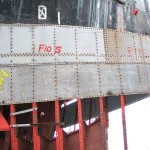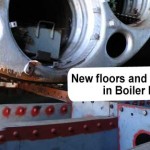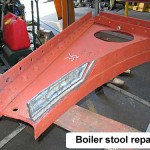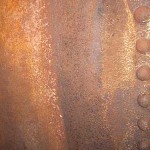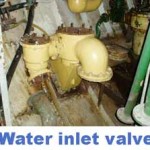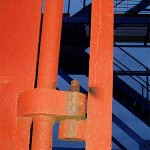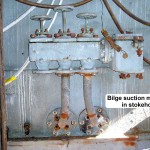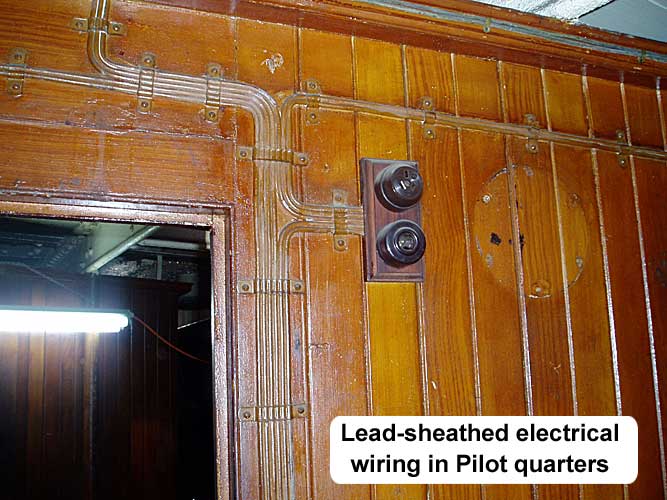John Oxley Restoration
Update January 2006
Steady progress is being made. The restoration of the structural parts, being the floors and frames, is nearing completion. More plates are being fixed to these structural parts. The year 2006 will see more visual progress than the preceding work, that had concentrated on the internal structure.
An interesting discovery was made during the dismantling of the panelling in the Pilot quarters. Inscribed on the steel plate behind the panel is a picture of a man in a bowler hat. In the days that the ship was build, 1927, it was customary that the Foreman wore a bowler hat and a three piece suit. The hat was in part a status symbol, and in part a basic “safety helmet” as protection against the accidental and “accidental” dropping of tools, bolts and rivets by the workmen.
Hull
| • | Plates A1 (in part), A2 and B2 have been removed and duplicated. These plates encase the propeller shaft tunnel. Plate |
| A2 is of a complex shape with a gradual changing angle to the bar keel. It was a challenge to replicate. The plates are | |
| now ready to be put on the hull. | |
|
|
|
| • | Plates F10 and F11, starboard, have been fitted to the hull at the stem. |
| • | Boiler support at frames 36 and 40 are being replicated. All other floors in the boiler room and stoke hold have been |
| completed, apart from a few intercostals. | |
| • | The boiler stools are under repair. Some need only minor inserts. It has been decided to bolt the boiler stools to the |
| floors rather than rivet them. | |
|
|
|
| • | The rust on the boilers at the stool supports is minor. The stool supports will be lined with lead sheeting to even out the |
| loading before the boilers are lowered onto them. | |
| • | Riveting is progressing slowly as we have a shortage of rivets. The new supply is not due till June 2006. |
Engineering
Current work is concentrated on the hull and underwater fittings such as the rudder and sea valves. These are clearly critical path components for refloat. After initial dismantling and removal from the hull, sea valves have now been sent out to the workshop of a sponsor who has undertaken over a period of time to grit blast, epoxy coat and refurbish these important fittings.
The rudder repair has been challenging as the steel pintles were tightly fitted into their tapers and rust locked as well. All pintles are now loosened and the rudder can now be swung from side to side by hand. Next challenges are to remove the tiller from the rudder head and then to remove the coupling bolts from the rudder palm. The rudder can then be lowered to the dock floor and plate repairs commenced.
Other refloat priorities include remanufacture of the original bilge suction system. This will require new cast iron manifolds and then galvanized steel piping runs to all compartments. Our volunteer patternmaker is currently making the patterns for the manifolds and sponsors have come forward to supply all castings, machining and piping requirements.
Rigging
The boom on the main mast, forward, has been lowered; reducing the load on the mast.
Electrical
While our volunteer electricians have well developed plans for the refurbishment of John Oxley’s electrical systems and are anxious to commence, they must wait until refloat before their real work on the ship can commence.
However, they are very active in supplying electrical services to the vessel, arranging power and light, and overseeing the heritage wiring aspects of the vessel.
The original 110 volt DC switchboard has been removed for safe storage ashore and eventual restoration.
Another challenge is to record the design of the original lead-sheathed wiring system so that it can be later replicated.
Planning
The work sequence has been refined based on our experience with the restoration of the plates so far. Below is the revision in an abbreviated format.
| • | Complete the floors in the boiler room and the forward floor in the engine room. |
| • | Replace or repair the hull plating that is not obstructed by bilge docking-blocks. |
| • | Restore A-strake while providing temporary additional support to B-strake. |
| • | Restore C and D-strake where the bilge docking-blocks are, removing and replacing one block at a time. |
| • | Prioritise engineering work to refloat and attend to repair of larger items inside the hull that can be better removed, |
| repaired and replaced while hull plates in engine room are removed. |

